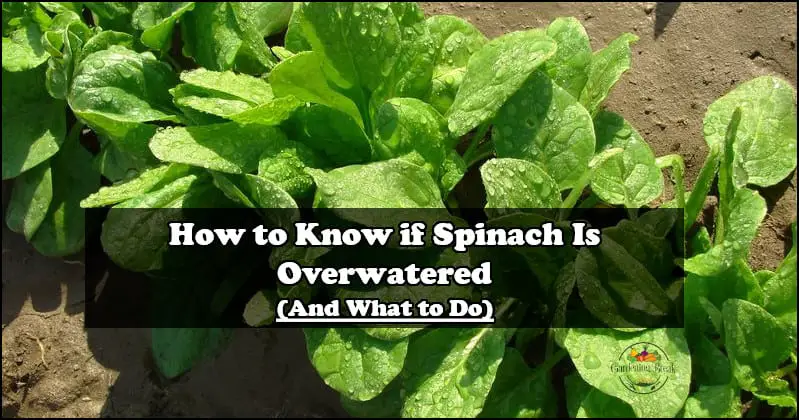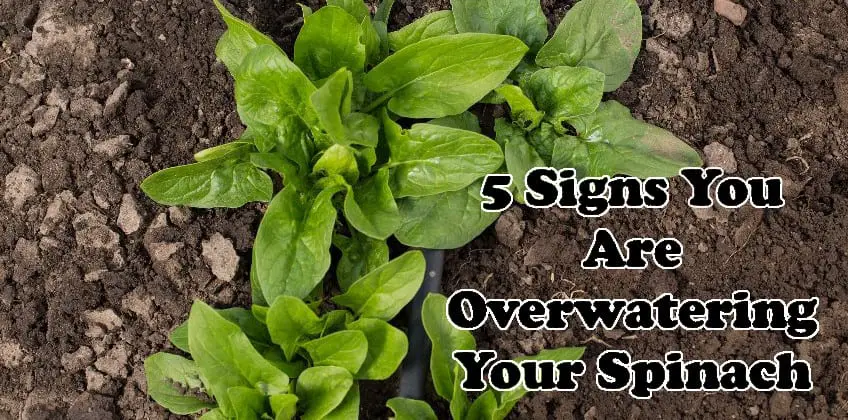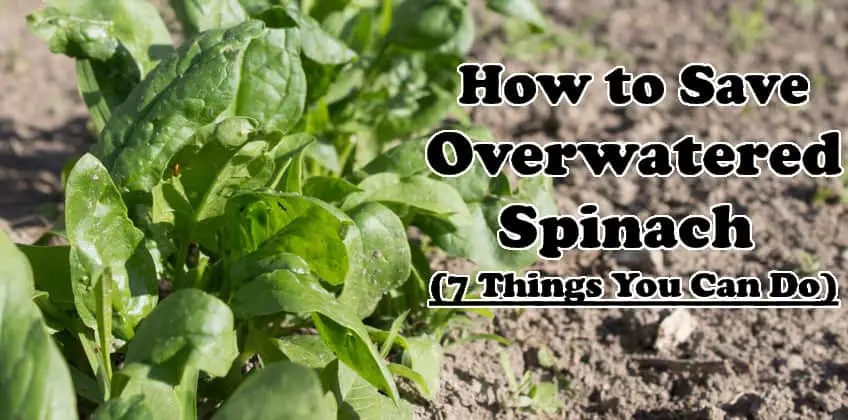This post contains affiliate links.
Overwatering is one of the most common mistakes people make when they grow spinach. Part of the reason why so many people overwater their spinach is that some of the signs of overwatering are very similar to the signs of underwatering, causing people to water their spinach more than they should. I have written this article to teach you how to tell if you are overwatering your spinach, how to save it, and how to avoid overwatering it in the future.
The first signs spinach is being overwatered are that the leaves begin to turn yellow and become soft and loose and look thirsty and tired even after being watered. Another sign of overwatering is that the soil doesn’t get dry but instead stays wet for several days after watering.

I have learned a lot about the issue of overwatering plants by talking to experts and other gardeners from several garden centers and plant nurseries. I used to overwater many plants, including spinach, in the past, but I (almost) never do it anymore, so I feel confident that I have some tips for you that can help you.
5 Signs You Are Overwatering Your Spinach
It can be tricky to tell if you are giving your spinach too much water since the initial damage happens to the roots, which can make it hard to notice before it is too late. Some of the signs of overwatering can also look like the plant is not getting enough water, and because of that, many people end up overwatering their spinach for a long time without noticing it before it is too late.
Luckily, there are some signs to look out for. I describe these below, and after that, I explain what you can do to save your spinach and how to avoid overwatering it again.
Here are five signs that you might be overwatering your spinach.

The plant looks thirsty and tired even after you water it
When you water spinach, it will usually “liven up” and look fresher with more stiff leaves than before once it begins obtaining the water. One of the first indicators that you are overwatering your spinach is that this doesn’t happen and that the plant instead looks thirsty, tired, and soft or loose even after you water it.
Wilting or drooping (which is when a plant’s leaves get soft or loose) is a very common reason why people overwater their spinach. This is simply because it can seem like the plant is thirsty, which makes people water it extra even though it already has too much water.
If the leaves on your spinach seem soft and loose, try to touch the soil and see if it is wet or dry before you water it. If it is wet, but the plant is still wilting or drooping, chances are you are overwatering it.
The outer leaves begin to turn yellow and brown
There are several reasons why the leaves on spinach plants begin to turn yellow sometimes. It can, for example, happen in warm, sunny, and dry weather where the plant needs more water than it gets, or it can happen if you overfertilize it, but the most common reason is probably overwatering.
If you notice the leaves on your spinach starting to turn yellow or brown, see if it shows any of the other signs of overwatering that I write about in this article. If you do, there is a good chance it has been overwatered and if that is the case, I recommend you jump a bit forward in this article to where I explain how to save it.
The soil stays wet for a few days after watering
Something you might notice if you are overwatering your spinach is that the top of the soil never really becomes dry. This can happen for a few reasons.
It can happen if you have been overwatering your spinach for some time and the roots have started rotting. The roots will begin to rot if the soil is too wet for too long and if that happens, the plant cannot obtain water and nutrients properly since the roots have been damaged.
This can also happen if you grow your spinach in pots or containers without proper drainage. While it is definitely possible to grow spinach in pots with poor drainage, it is a lot easier to overwater it since the plants can only obtain a certain amount of water per day, and any excess water will keep the soil wet, eventually causing the roots to rot.
I almost always use (and highly recommend) terra cotta pots with one or more drainage holes in the bottom. The drainage hole, of course, helps a lot with drainage, but the terra cotta material is also very breathable and allows moisture to escape through it. It reduces the risk of overwatering your plants by a lot.
Keep in mind that if a lot of direct sunlight reaches the ground where you water, the soil will dry up regardless of how the plants’ roots are doing. So if the top of the soil gets dry quickly, it doesn’t necessarily mean that you are not overwatering your spinach. There is definitely a chance though, so see if your spinach is showing any of the other signs I write about in this article.
The plant doesn’t grow as much as it used to or stops entirely
A very common sign of overwatering spinach (and other plants) that happens after a while of overwatering is that it begins to grow slower or even stops entirely.
This happens because the roots begin to rot, and, as I explained above, when the roots begin to rot, they cannot obtain water and nutrients, causing the plant to grow slower and slower until it stops entirely.
When the roots of spinach are completely rotten, it is very unlikely that the plant survives, but keep in mind that there are many potential reasons why a plant stops growing.
One reason why spinach might stop growing is that it doesn’t have enough room for its roots. Another more common reason is that it has started flowering because when that happens, the plant will shift its focus from growing and producing leaves to producing flowers and seeds. You can read much more about that and what to do when it happens in this article.
If your spinach is very young, there is a higher risk of overwatering it since the root system is still very small at that stage. There are, however, also other reasons why spinach seedlings stop growing or don’t sprout at all. I cover that a lot more in this article.
Mold begins to appear on the soil or the plant
Mold and mildew can appear on spinach for several reasons. One of the potential reasons is that the plant has been overwatered for a while.
I talked about how the soil might stay wet for a while if you are overwatering your spinach earlier in this article. This can sometimes end up causing mold to appear on the soil or even on the plant.
If you notice a small amount of mold on the soil around your spinach, you can usually scrape it off with a spoon or something else. If there is a lot of it or it appears on the actual plant, you have probably been overwatering it for a while, and it is, unfortunately, unlikely to survive.
Now that you know about the five signs of overwatering spinach that you have to look out for, I want to teach you what you can actually do to save your overwatered spinach.
How to Save Overwatered Spinach (7 Things You Can Do)
It might feel a bit alarming when your spinach begins to show signs of overwatering, but you don’t have to worry. At least not yet. Because there are several things you can do to save your spinach before it takes too much damage. I will teach you seven things you can do to save your overwatered spinach.

If you haven’t been overwatering your spinach for too long, there is a very good chance you can save it. Here are the seven methods for saving overwatered spinach, that I have had the most success with.
Water potted spinach from the bottom to promote root growth
If you are growing spinach directly in the ground, this tip won’t help you. If you are growing spinach in pots or containers with a plate underneath them, however, I have a cool trick that will reduce the risk of overwatering your spinach significantly.
The best watering method to avoid overwatering potted spinach is to pour the water into the plate and let it be soaked up rather than pouring the water on top of the soil.
Bottom watering encourages the roots to grow faster and bigger, so they can reach more water. This is great for you because the bigger your spinach’s root system is, the more water it can take without being overwatered.
If you don’t have pots with a plate underneath, I highly recommend you get some. They help prevent overwatering by allowing any excess water to escape from the pot. Some like these (link to Amazon) are really good and are what I use all the time.
You should not water your spinach before the top of the soil is dry, though, which is my next tip.
Let the top of the soil get dry before you water your spinach
Spinach grows best in soil that is moist and never completely dry or soaking wet. I have an easy trick to help determine when it is time to water your spinach to keep the soil moist and reduce the risk of overwatering.
Water your spinach when the top of the soil is dry to touch. An easy way to determine if it is time to water your spinach is to stick the tip of a finger into the soil, and if it comes out dry, you should water the plant. If it comes up moist, you should not.
I have also had a lot more success with spinach when I watered it in small but frequent doses instead of less frequent but heavier waterings. That also makes a lot of sense since it is easier to keep a consistent moisture level in the soil with more frequent but smaller doses of water.
This is the most reliable method I have found to figure out when you should water your spinach. I like this method much more and find it much more reliable than watering on a schedule since how much water spinach needs is affected by so many things like the weather, soil type, size of the plant, and much more.
The finger-in-the-soil method always works but takes a little bit of practice. That said, you will probably find that about one watering per day will work well, although I highly recommend feeling the soil. Remember that the soil should never get completely dry. Just the top of it.
Increase the amount of direct sunlight your spinach gets
Increasing the amount of sunlight your spinach gets is one of the most effective things you can do to save it if it is overwatered. If you can do something to increase the amount of sunlight your overwatered spinach gets, whether that is moving the plant or moving some furniture that blocks the sunlight, you should most likely do it.
The more direct sunlight spinach gets, the more water it can utilize. So if you have some spinach that has been getting too much water, exposing it to more sunlight is a great way to save it since it causes water to stay in the soil around the roots for less time.
The only thing you should keep in mind regarding moving your spinach to a sunnier place is that if it gets too much sunlight or the temperature is too high, it will start flowering a lot faster. When that happens, it won’t grow and produce new leaves at nearly the same rate. Spinach should generally not get more than 14 hours of sunlight per day. You can read much more about that in this article.
Remove mulch around the overwatered plants
Mulch is great. It reduces the number of weeds in your garden, it provides nutrients to the soil that help the plants grow better, and it helps retain moisture in the soil, so you don’t have to water as much.
When your plants have been getting too much water and are showing signs of overwatering, mulch is not your friend, however. Specifically, because it helps retain water in the soil.
If you have mulch around your spinach and the plants are showing signs of overwatering, I recommend that you remove the mulch from around the plants so that the sunlight can reach the soil directly. This will help the soil get dry faster and reduce the risk of your spinach’s roots rotting.
Remove the plate from underneath your potted spinach
If your potted spinach has been overwatered, it can be a very good idea to remove the plate from underneath it and put the plant somewhere it is okay for water to run through.
While one or more drainage holes at the bottom of the pot provide great drainage, water can still stay in the plate for a long time after you water the plant if you overwater it. If that happens, it can be a really good idea to remove the plate to allow as much water as possible to run through.
If you can find a place where the plant can stay without the plate while still getting sunlight, that works best. Just keep in mind that the soil shouldn’t get completely dry.
Remove any yellow, brown, or dead growth from the spinach
If some of the leaves on your overwatered spinach are turning yellow or brown or starting to feel soggy, you should remove them.
To be honest, you should always do this and not just when the plant is overwatered, but it mostly happens because of overwatering.
Removing yellowing or soggy leaves reduces the risk of mold and diseases spreading around the plant, so keep an eye out for that and remove them when you notice them.
Move your spinach to a bigger pot
I generally don’t recommend transplanting your spinach to another pot if it is overwatered, but there are situations where it can be helpful.
If your spinach is growing in a small pot and is showing signs of overwatering, it can be a good idea to move it to a bigger pot with more soil. Adding the extra soil will help soak the water from the soil around the roots and reduce the risk that the plant becomes damaged.
If your spinach is only showing very signs of overwatering, I don’t recommend transplanting it. I recommend that more as a “last resort” since there is a risk that the plant won’t survive it.
It can be a bit tricky to tell how much your spinach has been overwatered since most of the initial damage happens to the roots. Try to go over the five signs of overwatering I shared earlier in this article to help determine how severely the plant has been damaged before you decide if you want to move it to a bigger pot.
5 Simple Tips to Help You Avoid Overwatering Spinach
The best way to deal with overwatering spinach is to avoid overwatering it in the first place. If you have some overwatered spinach right now, I realize that this is not very helpful, however, I highly recommend that you keep reading since the tips I will share now can help you avoid overwatering your spinach ever again.

After overwatering many plants, including spinach, and talking to several other gardeners and experts from nurseries and garden centers about overwatering, I have learned some simple but really effective tricks that can help avoid it.
Always water your potted spinach from the bottom
Bottom watering is, of course, only possible if you grow your spinach in a pot or container with a plate underneath it. If you do that, I highly recommend watering from the bottom.
I already explained why bottom watering is good earlier in this article, but a quick summary is that it encourages root growth, and the more extensive root system a plant has, the more water it can take before it gets overwatered.
So if possible, I highly recommend that you water your spinach from the bottom once it has sprouted to reduce the risk of overwatering it.
Grow your spinach in terra cotta pots with drainage holes
The reason why terra cotta pots can help avoid overwatering plants is that the material allows some of the moisture to escape through the bottom and the sides of the pot.
It is also very important to grow your spinach in a pot with one or more drainage holes at the bottom, but in my experience, it seems like almost all the terra cotta pots I have come across have that. Just look out for that when you choose a pot.
Many people don’t consider this and grow their spinach in pots or containers made from a non-breathable material and without draining holes. This is a very common reason for overwatering spinach.
Grow your spinach in nutrient-rich soil with a high sand content
The type of soil you grow your spinach in has a big impact on how much water the plants need and how easily they get overwatered.
The best type of soil for growing spinach is nutrient-rich, well-drained soil with a lot of organic matter in it. The best soil for spinach has a high sand content since sand improves how well water drains through the soil, which is important for avoiding overwatering.
Soil types with a high content of clay make it harder for the roots to grow and spread while also retaining water better, so it increases the risk of overwatering significantly.
You can read a lot more about soil type and other growing conditions for spinach in this article.
Grow your spinach in a sunny location from the beginning
Spinach can grow in relatively little sunlight. Most varieties only require about four hours of sunlight per day to grow, but the more sunlight they get, the less likely they are to become overwatered.
The reason why more sunlight means less risk of overwatering is that the more sunlight spinach gets, the more water it needs and uses. Because of this, water doesn’t stay in the soil around the roots for as long if there is a lot of sunlight.
Planting your spinach in a sunny spot from the beginning is a great way to significantly reduce the risk of it becoming overwatered.
Spinach can grow both indoors and outside, but it is usually a lot easier to find a sunny spot outside. I share a lot more tips about that and explain the differences between growing spinach indoors and outside in this article.
Make sure the top of the soil is dry before watering
Spinach will die if the soil is too dry or too wet for too long. The soil needs to be consistently moist, and the best way to achieve that is to water only when the plant asks for it, rather than watering it on a fixed schedule.
The best way to know if your spinach needs water is to stick the tip of a finger into the soil. If the fingertip comes out dry, you should water the plant.
I generally don’t believe much in fixed schedules for watering plants since many things affect when and how much water plants need. This can be the weather, plant size, soil type, amount of water it gets, and a lot more.
Again, the key is to keep the soil moist and never wet or dry.
What Happens if You Don’t Save Your Overwatered Spinach?
Spinach can be overwatered for some time without taking any significant damage, but once the roots begin to rot, things happen fast.
If spinach is overwatered for too long without being saved, the roots will rot. When that happens, the plant can no longer obtain water and nutrients from the soil and will die pretty fast.
When you overwater spinach, the damage happens gradually and slowly, but because you can’t see the roots, which is where it begins, it can seem like it is happening very rapidly.
You can usually save your spinach after overwatering without that much effort, so I highly recommend following the steps I shared in this article.
